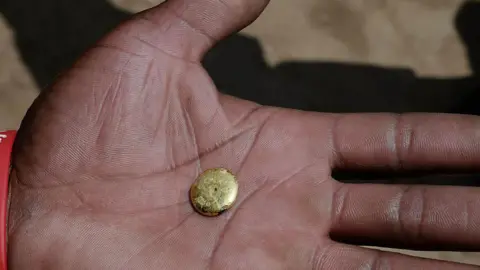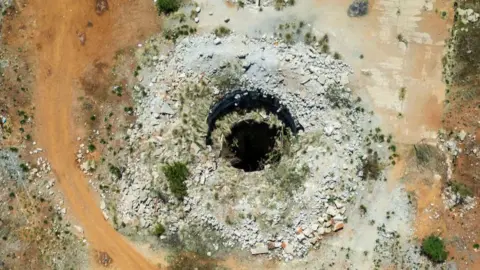BBC News, Johannesburg
 Getty Images
Getty ImagesThis story contains details, including a video, that some people may find distressing.
The most shocking thing for Jonathan, who had endured six gruelling months living and working underground in an abandoned South African gold mine, was the abuse he witnessed being meted out to children.
Some are recruited for cheap labour, but others are brought in specifically for sex, campaigners say.
Jonathan, now in his late 20s, had migrated to South Africa from a nearby country on the promise of making easy money working in one of its dozens of disused mines, closed by multinationals because they were no longer commercially viable.
We are protecting his full identity as he fears reprisals from the vicious criminal gangs that run the illegal mining industry for speaking to the media.
Details of what the young people were going though emerged after the death of dozens of illegal miners near the town of Stilfontein late last year when the mine was blockaded by police.
In a calm and steady voice, Jonathan describes the heat, long hours and limited food and sleeping options which took a toll on his body.
But an enduring memory is what happened to the underage miners in the shaft where he worked.
“I used to see these kids in the mine – teenagers actually, 15, 17-year-olds.
“Others used to take advantage of them sometimes. It was a little bit scary, and I wasn’t comfortable with it.”
He said they were raped by adult miners who promised to give them some of the gold they found in exchange for sex.
“If that kid is desperate for money, he will take the risk.”
Jonathan describes how the children would approach teams of miners for protection but “that team would have conditions”.
Sex was also used as punishment if the teenagers failed to complete a task for their team.
Jonathan says the children in the mine where he worked were all foreign and did not realise what they were getting themselves into.
 AFP
AFPMining researcher and activist Makhotla Sefuli backs this up.
He says criminal gangs specifically target children to work in illegal mines across South Africa.
Many of them are abducted from neighbouring countries and trafficked. They are enticed by baseless promises of finding them employment in the formal mining industry.
“Their passports are confiscated when they get to South Africa… It is common knowledge that these young boys are being abused,” Mr Sefuli says.
The BBC has spoken to miners who worked in at least two other illegal mines who told us they saw children being abused in the shafts where they were working.
Tshepo, not his real name, says he saw older men forcing young boys to have sex with them underground.
“In some instances, they did it for the money. Some are recruited solely for that purpose, because of the financial incentives that will come with the practice of maybe trading sex underground.”
He adds that the abuse deeply affected the children.
“They change their behaviour patterns and have trust issues. They don’t want you to get close to them, because they feel that they can no longer trust anyone.”
South Africa’s illegal mining industry made global headlines last year following a standoff between police and miners at the Buffelsfontein gold mine, near the town of Stilfontein in the North West Province.
The authorities had been trying to curb illegal mining, which the government said cost South Africa’s economy $3.2bn (£2.6bn) in lost revenue last year.
They launched an operation called Vala Umgodi, or seal the hole, in December 2023, promising to take a tough stance on the gangs.
As part of the operation, the police limited the amount of food and water that went down the Stilfontein mine to, as one minister put it, “smoke out” the illegal miners. Officials said the men were refusing to come out for fear of being arrested.
Soon footage began to emerge from within the mine showing dozens of emaciated men begging to be rescued, as well as rows of body bags. Eventually a court ordered the authorities to save the men.
Among those brought up were many who said they were underage, but as a number of them were migrants without documents confirming how old they were, the authorities carried out medical tests to get an estimate.
Through this, the Department of Social Development (DSD) confirmed that 31 of the rescued Stilfontein miners were found to be children. They were all Mozambicans nationals and in November, 27 of them were repatriated.
Save the Children South Africa helped translate some of the interviews between the underage miners and the rescue workers.
“They went through trauma, because some of them also saw others being sexually exploited,” the charity’s CEO Gugu Xaba tells the BBC.
“Just the feeling that they may not come out of there destroyed those children mentally.
“The adult miners would start by grooming them, by acting like they like them.”
She says the children were then made to perform sexual acts on the adults and they were then raped, days after day.
“You find that the adult will have three or four of them that they are doing the same thing to.”
Ms Xaba says mining gangs recruit children because they are easier to manipulate and cheaper.
“Children don’t understand when you say: ‘I’ll pay you 20 rands ($1; £0.80) per day.’ The adults sometimes refuse to work, but children find themselves with no choice. So it’s easier to use a child to do the work. It’s easier to take a child who’s kind of voiceless and to bring them down there.”
Beyond being exploited financially, she says there are gangs that recruit children specifically for sex.
Many illegal miners spend months underground, rarely going up to the surface. Markets spring up underground to provide them with anything they need.
“Most children are trafficked in order to be used as sex slaves. And you’ve got a pimp who is taking the money, and it means every day this child is used as a commercial sex worker.”
The BBC asked the police and the DSD whether anyone would be charged over the sexual abuse allegations. They did not respond to our requests.
A source working on the Stilfontein miners’ cases said many of the children did not want to testify.
Meanwhile, the illegal mining industry continues to thrive.
And with an estimated 6,000 vacant mines potentially available to explore, it is a business that is unlikely to end anytime soon, leaving thousands of vulnerable children at risk.
More South Africa stories from the BBC:
 Getty Images/BBC
Getty Images/BBC
